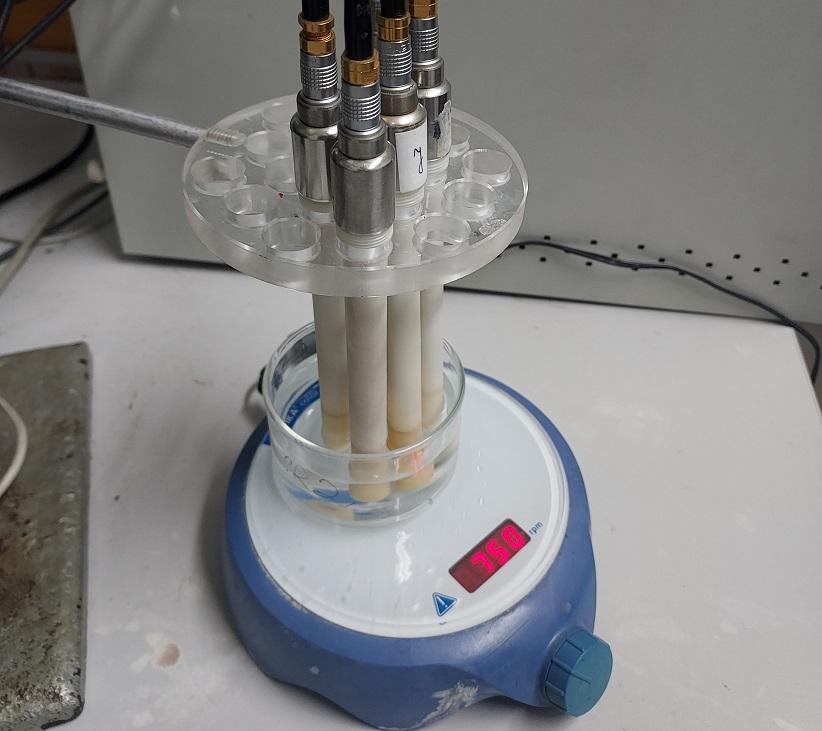Our scientists’ idea to improve epidermal sensors
A tattoo that monitors a patient's health? It may sound exotic, but not for the scientists from the Faculty of Chemistry of the Warsaw University of Technology, who worked on the development of a reference electrode for an 'electronic tattoo', i.e. a non-invasive analytical device with sensors placed on its surface, as part of the BIOTECHEMED-2 grant.

Electrodes with polymer reference membranes, used to study the influence of the type of ionic liquid on potential stability.
Electronic tattoos are otherwise known as epidermal sensors, i.e. devices in the form of stickers, usually made of foil, which can be applied directly to the skin. But for what purpose?
“One of the samples that can be used for non-invasive measurements is sweat. The composition of sweat reflects the patient’s health condition and is related to the physiological and metabolic processes taking place in the body. As a biomedical sample, sweat is easy to collect and is produced naturally. This is especially important as we are developing our work to monitor the health of athletes and people undergoing physical rehabilitation,” says Professor Łukasz Górski from the Faculty of Chemistry at the Warsaw University of Technology.
Ion-selective electrodes are used as sensors in electronic tattoos, among other things. As part of a project funded by the IDUB programme, the researchers at the Warsaw University of Technology focused on establishing a link between the structure and properties of ionic liquids and the stability of the potential of miniature reference electrodes based on these compounds. The stability of the potential of such electrodes significantly affects the accuracy of the results of the conducted electrochemical analysis.
“The miniaturisation of indicator electrodes used in potentiometry is a widely discussed research area. Unfortunately, in most cases, the published scientific papers focus on measuring miniature indicator electrodes as compared to large reference electrodes. Such a solution does not make sense, especially for electronic tattoos that need to adhere to the body,” explains Professor Górski.
The scientific literature provides information on several types of membranes for use in reference electrodes, but due to their composition (e.g. sodium chloride in a polymer membrane) they are difficult to apply, uncomfortable and do not adhere.
Researchers at PW have developed membranes containing ionic liquids that dissolve into the membrane and stabilise the electrode potential.
“Our research shows that the type of ionic liquid used, i.e. its specific physicochemical properties, impacts the stability of the electrode potential. The liquid must have similar partition coefficients for the anion and cation. This cannot be directly measured, but it can be computer-modelled and one can check at which partition coefficient greater stability of the electrode potential will be obtained,” explains Professor Górski.
Currently, scientists at CEZAMAT are working on the technology of applying the developed membranes to the indicator electrodes. They aim to develop a method that will facilitate mass printing, i.e. low production costs and, consequently, offer the possibility of purchasing such tattoos in the future by amateur athletes, for example. Aerojet-printing technology seems to make this goal achievable. Current work is being conducted as part of the project “Functional composite materials for printable sensors for telerehabilitation” (TECHMATSTRATEG-III/0032/2019, head: Professor Małgorzata Jakubowska), which was financed by the funds of the National Centre for Research and Development.
The project “Ionic liquids as components of reference electrode membranes in devices for sweat analysis” was funded as part of the research grant under the “Excellence Initiative – Research University” programme implemented at the Warsaw University of Technology.
Research team:
Professor Łukasz Górski; Professor Marek Królikowski; Professor Ilona Grabowska-Jadach; Professor Marta Królikowska; Kinga Kochman, BSc.

